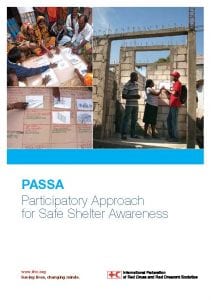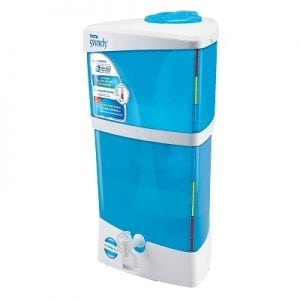
Agriculture
December 29, 2023
Safe Water Book
Read SolutionImplemented by
Folia Water

Updated on September 23, 2023
·Created on September 2, 2016
Target Countries
Kenya, Malawi, Uganda
Target Users (Target Impact Group)
Community, NGOs
Distributors / Implementing Organizations
Evidence Action and Innovations for Poverty Action (IPA)
Countries
Kenya, Malawi, Uganda
Manufacturing/Building Method
The dispenser is installed near a water source. It is fitted with a valve that consistently delivers a precise 3 ml dose of chlorine. The tank is filled with sodium hypochlorite (chlorine) solution and installed at the water source in a protective casing. Community members go to their water source, place their bucket or jerrycan under the dispenser, turn the valve to dispense the correct amount of chlorine, and then fill the bucket with water. The chlorine disinfects the water within 30 minutes, then the chlorine residual prevents recontamination for 2-3 days.
Intellectural Property Type
Open Source
User Provision Model
Purchased by NGOs and donated to communities. In every community with a dispenser, there is an elected, local community promoter who is responsible for the dispenser and educates villages on how to use it.
Distributions to Date Status
Unknown
Design Specifications
Dispensers are a 3 or 5 liter plastic container filled with 1.25% chlorine solution and fitted with a valve that doses 3 mL of solution per 20 Liter water container. They are fixed on a post in the ground near a water collection point.
Technical Support
Chlorine refills are delivered to the local promoter at each dispenser every two to three months. There are hotlines for promoters to contact with any issues, and repair dispenser hardware as needed. Dedicated field officers regularly monitor service delivery operations and adoption rates, which are used to adjust operations as necessary, hold staff accountable for service delivery targets, and track impact.
Replacement Components
There is a financing mechanism to recover a part of costs, which helps ensure that target communities have access to chlorine to make their water safe in the home for free.
Lifecycle
The chlorine in the dispensers can last at least 3 months. Each full dispenser will treat water for ~150 people for ~1 month before needing refilled.
Manufacturer Specified Performance Parameters
The chlorine should make the water safe from bacteriological contamination for 2-3 days.
Vetted Performance Status
Dispensers in emergency contexts are more likely to be effective if: installed at point-sources, a high-quality chlorine solution manufacturing and distribution chain is maintained, Dispenser hardware is maintained, Dispensers projects are within larger water programs integrated, Promoters are compensated, project staff is experienced, local partners are involved with implementation, ongoing monitoring is conducted, and if projects have sustainability plans.
Safety
Some household water treatment technologies are less effective if chlorinated water is used, for example filter with silver added or biosand filters.
Complementary Technical Systems
Safe storage container for water collection and storage.
Academic Research and References
Kremer, M., et al., Sustainability of Long-Term Take-Up at Point-of-Collection Chlorine Dispensers Provided Free of Charge in Rural Western Kenya, Proceedings of the Water Environment Federation, 2011, pp. 249-250.
Yates, T.M., et al., Effectiveness of Chlorine Dispensers in Emergencies: Case Study Results from Haiti, Sierra Leone, Democratic Republic of Congo, and Senegal, Environmental Science and Technology, 2015, 49 (8), pp. 5115-5122.
Ahmed, A., et al., Operational Models for Chlorine Dispensers at Communal Water Sources: Lessons from Government Partnerships in Kenya, Proceedings of the Water Environment Federation, 2011, pp. 412-415.
T. M. Yates, E. Armitage, L. V. Lehmann, A. J. Branz, and D. S. Lantagne, “Effectiveness of chlorine dispensers in emergencies: Case study results from Haiti, Sierra Leone, democratic republic of Congo, and Senegal,” Environ. Sci. Technol., vol. 49, no. 8, pp. 5115–5122, 2015
E. Action, “Safe Water Now,” Evidence Action, 10-Jul-2023. Available: https://www.evidenceaction.org/programs/safe-water-now#why-dispensers-for-safe-water-is-better
“Chlorine Dispensers for Safe Water,” Poverty-action.org. Available: https://poverty-action.org/chlorine-dispensers-safe-water
“Goal 6,” Sdgs.un.org. Available: https://sdgs.un.org/goals/goal6
Mwawater.org. Available: https://mwawater.org/wp-content/uploads/2012/05/Presentation-Dispensers-MWA.pdf
“Chlorine (Sodium Hypochlorite),” Akvopedia.org. Available: https://akvopedia.org/wiki/Chlorine_(Sodium_Hypochlorite)
S. Pole, “Chlorine Dispensers for Safe Water in Uganda,” 29-Jul-2014. Available: https://www.youtube.com/watch?v=YzNtYGOt55w
Compliance with regulations
Chlorine is widely recognized and used for treating drinking water.
Evaluation methods
Field evaluations have been carried out in both emergency and development contexts.
Other Information
Video on Chlorine Dispensers in Uganda.

Agriculture
December 29, 2023
Implemented by
Folia Water

Agriculture
January 16, 2024
Implemented by
Solvatten

Agriculture
January 8, 2024
Implemented by
JanaJal

Agriculture
September 27, 2024
Implemented by
PATH

Agriculture
June 22, 2024
Implemented by
SafeBoda

Agriculture
March 8, 2024

Agriculture
March 8, 2024

Agriculture
September 26, 2023

Agriculture
January 1, 2024
Implemented by
TATA Swach

Agriculture
January 24, 2024
Implemented by
AidGear
Have thoughts on how we can improve?
Give Us Feedback
Manufacturing of this type of product requires documented process and assembly standards. In volumes of 100 special attention needs to be paid to ensure that each unit is not a unique “one of†but rather follows and industrialized, documented and controlled assembly and test process. This is especially true for units that generate and rely on high temperatures and pressures. Special processing and certifications to ensure that sterilization chambers and piping have been manufactured as required to ensure safety under these conditions is necessary.
Noel Wilson says:
Health target maybe should just refer to increased water access? There is no treatment tech on this product currently.
Pumping performance curves are very useful, and are a good example of the kind of performance curves necessary to better evaluate other systems.
Hello, We are planning a project on chlorine dispenser and we want to use this plastic quality as it has been used by so many organisations in Kenya, Uganda and Malawi. How can we contact the supplier?
Your assistance will be highly appreciated.
Thank you
Good day! please how do we purchase this point of use chlorine dispensers for some rural communities in Nigeria?